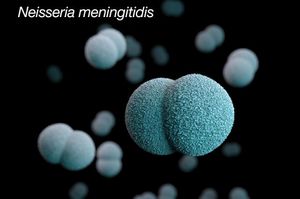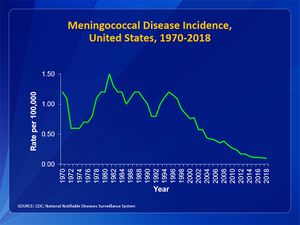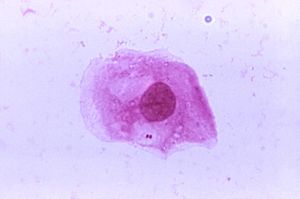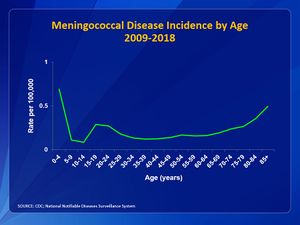Metabolism in Neisseria meningitidis: Difference between revisions
No edit summary |
No edit summary |
||
| Line 33: | Line 33: | ||
<br><b>Certain Medical Conditions</b> | <br><b>Certain Medical Conditions</b> | ||
<br>There are certain medical conditions and medications that may weaken the immune system and increase the risk of a person acquiring a meningococcal disease. The CDC has made a recommendation that individuals with a persistent complement component deficiency need to receive 2 vaccines (a meningococcal conjugate (MenACWY) vaccine and a serogroup B meningococcal (MenB) vaccine) for protection against meningococcal disease <ref name=medicalcond>[https://www.cdc.gov/meningococcal/about/risk-medical.html Certain Medical Conditions as a Risk Factor, CDC, Accessed April 20th, 2020]</ref>. A persistent complement component deficiencies are disorders affecting the complement system, which is what helps the body fight infections <ref name=medicalcond/>. Other situations where an individual will require 2 vaccines are people who are taking complement inhibitors, people with functional or anatomic asplenia (a nonfunctional or missing spleen), and people with HIV <ref name=medicalcond/>. | <br>There are certain medical conditions and medications that may weaken the immune system and increase the risk of a person acquiring a meningococcal disease. The CDC has made a recommendation that individuals with a persistent complement component deficiency need to receive 2 vaccines (a meningococcal conjugate (MenACWY) vaccine and a serogroup B meningococcal (MenB) vaccine) for protection against meningococcal disease <ref name=medicalcond>[https://www.cdc.gov/meningococcal/about/risk-medical.html Certain Medical Conditions as a Risk Factor, CDC, Accessed April 20th, 2020]</ref>. A persistent complement component deficiencies are disorders affecting the complement system, which is what helps the body fight infections <ref name=medicalcond/>. Other situations where an individual will require 2 vaccines are people who are taking complement inhibitors, people with functional or anatomic asplenia (a nonfunctional or missing spleen), and people with HIV <ref name=medicalcond/>. | ||
<br><b>Travel</b> | |||
[[Image:meningitisbelt.png|thumb|300px|right|Fig 5. Above features a map of the meningitis belt, an area in sub-Saharan Africa where the rate of meningococcal disease is very high. The dark blue area marks countries that are at high risk for an epidemic (the meningitis belt). The lighter blue marks countries that are at risk for a meningitis epidemic<ref name=beltmap>[https://wwwnc.cdc.gov/travel/yellowbook/2020/travel-related-infectious-diseases/meningococcal-disease#4670 Travel-Related Infectious Diseases, CDC, Accessed April 20th, 2020]</ref>.]] | |||
<br>The meningitis belt is an area in sub-Saharan Africa that has a high rate of meningococcal disease. In this area, there are much higher rates of meningococcal disease than in the United States and outbreaks are very common <ref name=traveling>[https://www.cdc.gov/meningococcal/about/risk-travelers.html Travel as a Risk Factor, CDC, Accessed April 20th, 2020]</ref>. Because of this, people who live in or are traveling to the meningitis belt are recommended to receive the meningococcal conjugate vaccine<ref name=traveling/>. The disease is most common in the meningitis belt during the dry season, which occurs from December through June <ref name=traveling/>. Travelers who are spending a lot of time with local populations, especially during outbreaks, are at the highest risk of getting sick <ref name=traveling/>. Even if a traveler has been vaccinated, if they continue to be at an increased risk, the traveler should receive booster doses of the vaccine <ref name=traveling/>. | |||
==Causes and Transmission== | ==Causes and Transmission== | ||
Revision as of 17:01, 24 April 2020
Introduction

By Molly Folks
Neisseria meningitidis (N. meningitidis) is Gram-negative bacterium that is a member of the class, Betaproteobacteria. Neisseria are aerobic heterotrophic cocci, and the cocci of Neisseria genus form diplococci, distinctive pairs of cocci (Fig 1) [2]. Most members of the Neisseria genus are commensal organisms that colonize the nasal and oral mucosa of animals. There are 11 species of Neisseria that colonize humans and only 2 are pathogens, Neiserria meningitidis and Neiserria gonorrhoeae.
N. meningitidis was first discovered in 1887 by Anton Weichselbaum after analyzing the cerebrospinal fluid (CSF) of a patient who was infected with meningitis [3]. There are at least 12 known serotypes of N.meningitidis based on the unique capsular polysaccharides seen on the cell surface [3]. Serotypes are groups that are found within a single microorganism, such as viruses and bacteria, that share differentiating surface structures [4]. Serotypes A, B, C, W, X, and Y are the serotypes that cause most of the meningococcal infections [3]. Each of these common serotypes can be linked to various regions around the globe. The main serotypes causing meningococcal disease in Africa are serotypes A and C [3]. Serotypes B and C are the main serotypes seen in Europe and the Americas [3]. Serotype Y is what generally causes infection in the United States and Canada [3]. Epidemic outbreaks around the world are linked to serotype W [3].
N. meningitidis is one of the common and important causes of community-acquired bacterial meningitis in the United States [3]. Children and adults can be infected by this bacterium. The infection has a high mortality rate if not recognized and treated immediately following the diagnosis. N. meningitidis can lead to other infections as well such as; meningococcal septicemia, pneumonia, septic arthritis, pericarditis, and urethritis [3]. This bacterium can cause both endemic and epidemic infections, also having the ability to infect young, healthy adults [3].

Due to the routine use of the meningococcal vaccination, the number of reported cases of meningococcal disease has decreased (Fig 1). In the United States, the number of cases each year is less than 1 case per 100000 [3]. February through March present the highest infection rates seen in the United States [3]. Infants less than 1-year old make up the highest rate of meningococcal disease seen with 5.38 cases per 100000 [3]. In sub-Saharan Africa, N.meningitidis has led to endemics and epidemic outbreaks and is an important cause of bacterial meningitis [3]. The mortality rate is very dependent on whether those who are infected have sought treatment or not. The mortality rate for individuals who have received treatment ranges from approximately 10 to 14% [3]. In patients who do not receive treatment, the mortality rate rises up to 50% [3].
Invasive Behavior

N. meningitidis or meningococci are obligate commensals in humans, meaning that the bacterium is colonizing the nasal and oral mucosa of humans without causing them harm. This phenomenon of the bacterium remaining in the mucosa without harming the human is known as carriage [6]. Approximately 10% of the population may carry N. meningitidis in the upper airway during nonepidemic situations and act as asymptomatic carriers [6]. The time in which one person remains in the carrier state can vary between being chronic, lasting for several months, intermittent or transient [6]. It has been seen that colonization of the meningococci can induce an antibody response from the three major immunoglobulin classes and may act as an immunizing event [6]. This situation will occur within a few weeks of obtaining the bacterium.
However, the bacterium does have the ability to enter the bloodstream. On occasion, shortly after colonization in the upper airway, N. meningitidis strains can penetrate the mucosal membrane and from there enter the bloodstream [6]. Once the bacterium has entered the bloodstream, various forms of disease caused by the bacterium may develop. It is important to note that non-carriers are at high-risk for meningococcal disease because it is unknown about their capability to maintain a commensal relationship with an acquired strain of N. meningitidis [6].
Risk Factors

As seen in most diseases, there are certain risk factors that put some people at an increased risk for acquiring a meningococcal disease. These risk factors include age, group settings, certain medical conditions, and travel [8].
Age
In the United States, infants, teens, and young adults have the highest incidence of meningococcal disease [7]. In Fig 4, the incidence of meningococcal disease among age groups is shown. It can be that the two largest peaks are at children less than 1-year-old and in teen and young adults from ages 16 to 23. Incidence drops after age 23. However, it can be seen that the rate begins to rise again after age 55, showing that people of old age are also at risk (Fig 4).
Group Settings
Wherever large groups are present, infectious diseases tend to spread. Recent data has shown that college students are at a higher risk for meningococcal disease than teens and young adults that are not attending college [9]. College campuses are the most known group settings for the spread of meningococcal disease, however, group settings can also include military recruits and even the common household [6].
Certain Medical Conditions
There are certain medical conditions and medications that may weaken the immune system and increase the risk of a person acquiring a meningococcal disease. The CDC has made a recommendation that individuals with a persistent complement component deficiency need to receive 2 vaccines (a meningococcal conjugate (MenACWY) vaccine and a serogroup B meningococcal (MenB) vaccine) for protection against meningococcal disease [10]. A persistent complement component deficiencies are disorders affecting the complement system, which is what helps the body fight infections [10]. Other situations where an individual will require 2 vaccines are people who are taking complement inhibitors, people with functional or anatomic asplenia (a nonfunctional or missing spleen), and people with HIV [10].
Travel
The meningitis belt is an area in sub-Saharan Africa that has a high rate of meningococcal disease. In this area, there are much higher rates of meningococcal disease than in the United States and outbreaks are very common [12]. Because of this, people who live in or are traveling to the meningitis belt are recommended to receive the meningococcal conjugate vaccine[12]. The disease is most common in the meningitis belt during the dry season, which occurs from December through June [12]. Travelers who are spending a lot of time with local populations, especially during outbreaks, are at the highest risk of getting sick [12]. Even if a traveler has been vaccinated, if they continue to be at an increased risk, the traveler should receive booster doses of the vaccine [12].
Causes and Transmission
Signs and Symptoms
Include some current research, with at least one figure showing data.
Treatment and Prevention
Include some current research, with at least one figure showing data.
Metabolism and Virulence
Conclusion
References
- ↑ 1.0 1.1 Meningococcal Photos, CDC, Accessed April 20th, 2020
- ↑ Slonczewski, J., and Foster J. W.. Microbiology: An Evolving Science. New York
- ↑ 3.00 3.01 3.02 3.03 3.04 3.05 3.06 3.07 3.08 3.09 3.10 3.11 3.12 3.13 3.14 3.15 [Nguyen N, Ashong D. Neisseria Meningitidis. [Updated 2020 Mar 4]. In: StatPearls [Internet]. Treasure Island (FL): StatPearls Publishing; 2020 Jan-. Available from: https://www.ncbi.nlm.nih.gov/books/NBK549849/ ]
- ↑ Serotypes and the Importance of Serotyping Salmonella, CDC, Accessed April 20th, 2020
- ↑ Surveillance, CDC, Accessed April 20th, 2020
- ↑ 6.0 6.1 6.2 6.3 6.4 6.5 6.6 Yazdankhah, S. P., & Caugant, D. A. (2004). Neisseria meningitidis: an overview of the carriage state. Journal of Medical Microbiology, 53(9), 821–832. doi: 10.1099/jmm.0.45529-0
- ↑ 7.0 7.1 Age as a Risk Factor, CDC, Accessed April 20th, 2020
- ↑ Risk Factors, CDC, Accessed April 20th, 2020
- ↑ Group Settings as a Risk Factor, CDC, Accessed April 20th, 2020
- ↑ 10.0 10.1 10.2 Certain Medical Conditions as a Risk Factor, CDC, Accessed April 20th, 2020
- ↑ Travel-Related Infectious Diseases, CDC, Accessed April 20th, 2020
- ↑ 12.0 12.1 12.2 12.3 12.4 Travel as a Risk Factor, CDC, Accessed April 20th, 2020
Authored for BIOL 238 Microbiology, taught by Joan Slonczewski, 2018, Kenyon College.
